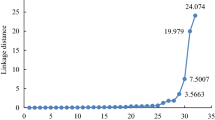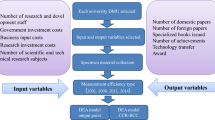Abstract
Over the last two decades, the interest to assess the quality of university teaching and research has considerably grown. This paper presents a study concerning the evaluation of the departments of the University of Firenze using Data Envelopment Analysis. It shows several applications with different variables choices to assess the performance both in teaching and in research activities. The reliability of the preferred specification was verified with a heuristic experiment, using different variables and a different number of variables. Particular attention is given to the problem of data availability and quality (e.g. for research output assessment).






Similar content being viewed by others
Notes
The literature on DEA is really vast; for the model description we basically refer to Coelli et al. (2005).
We used DEAP, a free software developed by T. Coelli that can be downloaded at the web site www.uq.edu.au/economics/cepa/deap.htm.
Source: MIUR database: http://statistica.miur.it.
References
Adler, N., Friedman, L., & Sinuany-Stern, Z. (2002). Review of ranking methods in the data envelopment analysis context. European Journal of Operational Research, 140, 249–265.
Agasisti, T., & Dal Bianco, A. (2006). Data envelopment analysis to the Italian university system: theoretical issues and policy implications. International Journal of Business Performance Management, 8(4), 344–367.
Banker, R. D., Charnes, A., & Cooper, W. W. (1984). Models for est8imation of technical and scale inefficiencies in data envelopment analysis. Management Science, 30, 1078–1092.
Charnes, A., Cooper, W. W., & Rhodes, E. (1978). Measuring the efficiency of decision making units. European Joural of Operational Reasearch, 2, 429–444.
CIVR (2007) Relazione finale. VTR 2001-2003, Roma.
Coelli, T. J., Prasada Rao, D. S., O’Donnell, C. J., & Battese, G. E. (2005). An introduction to efficiency and productivity analysis (2nd ed.). New York: Springer.
Dantzig, G. B. (1951). Maximization of a linear function of variables subject to linear inequalities. In T. Koopman (Ed.), Activity analysis of production and allocation. New York: John Wiley and Sons, Inc.
Farrell, M. J. (1957). The measurement of productive efficiency. Journal of the Royal Statistical Society, Series A, CXX, Part, 3, 253–290.
Flagg, A. T., Allen, D. O., Field, K., & Thurlow, T. W. (2004). Measuring the efficiency of British universities: a multi-period data envelopment analysis. Education Economics, 12(3), 231–249.
Golany, B., & Tamir, E. (1995). Evaluating efficiency-effectiveness-equality trade-offs: a data envelopment analysis approach. Management Science, 41(7), 1172–1184.
Ioannidis, J., Patsopoulos, N. A., Kavvoura, F. K., Tatsioni, A., Evangelou, E., Kouri, I., et al. (2007). International ranking systems for universities and institutions: a critical appraisal. BMC Medicine, 5, 30.
Kao, C., & Hung, H. T. (2008). Efficiency analysis of university departments: an empirical study. Omega, 36, 653–664.
Lambert, R., & Butler, N. (2006). The future of European universities. Renaissance or decay? London: Centre for European Reform.
McMillan, M. L., & Chan, W. H. (2005). University efficiency: A comparison and consolidation results from stochastic and non-stochastic methods. Working Paper Series, 2005-04, University of Alberta, Department of Economics.
Moreno, A. A., & Tadepali, R. (2002). Assessing academic department efficiency at a public university. Managerial and Decision Economics, 23, 385–397.
NUV-Nucleo di Valutazione dell’Università di Firenze (2007). Rapporto 2005/2006, Università di Firenze.
OECD. (1987). Universities under scrutiny. Paris: OECD.
Shanghai Jiao Tong University (2007). Academic ranking of world universities, Institute of Higher Education, Shanghai Jiao Tong University.
Wagner, J. M., & Shimshak, D. G. (2007). Stepwise selection of variables in data envelopment analysis: procedures and managerial perspectives. European Journal of Operational Research, 180, 57–67.
Author information
Authors and Affiliations
Corresponding author
Rights and permissions
About this article
Cite this article
Buzzigoli, L., Giusti, A. & Viviani, A. The Evaluation of University Departments. A Case Study for Firenze. Int Adv Econ Res 16, 24–38 (2010). https://doi.org/10.1007/s11294-009-9243-6
Received:
Published:
Issue Date:
DOI: https://doi.org/10.1007/s11294-009-9243-6




